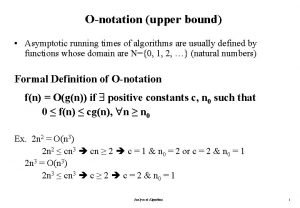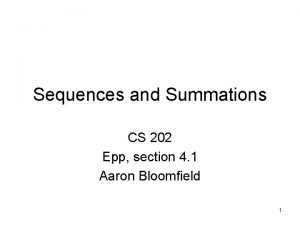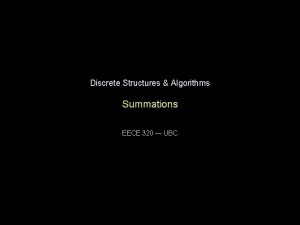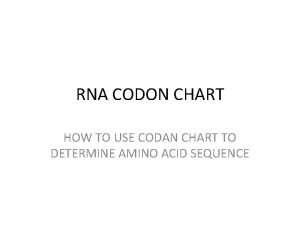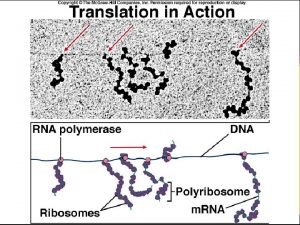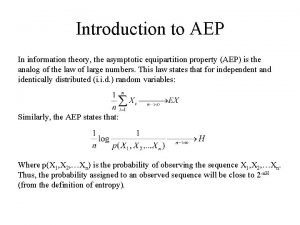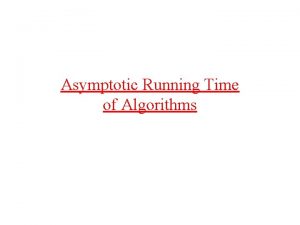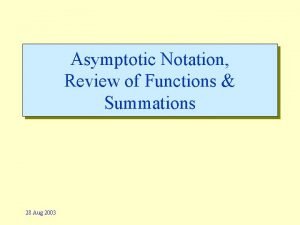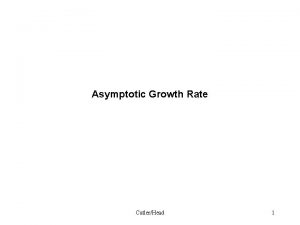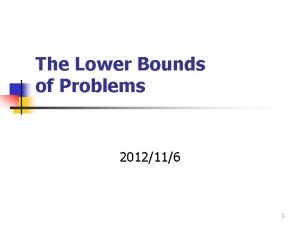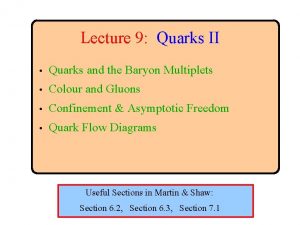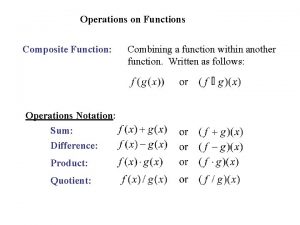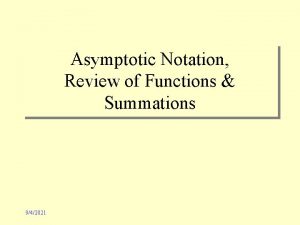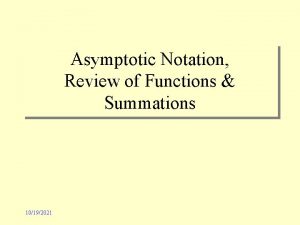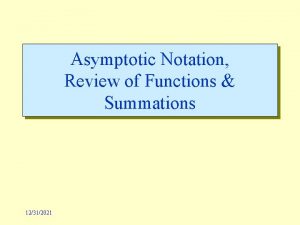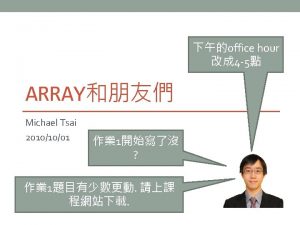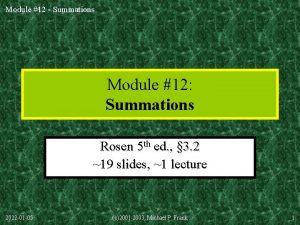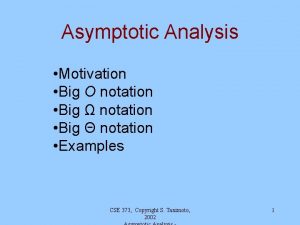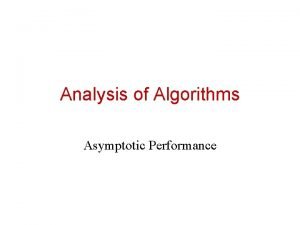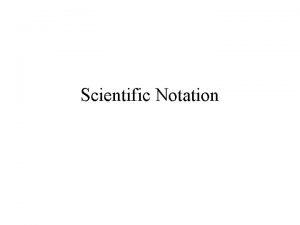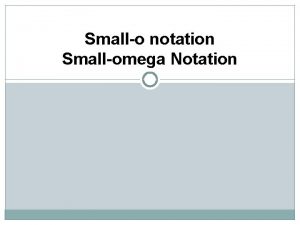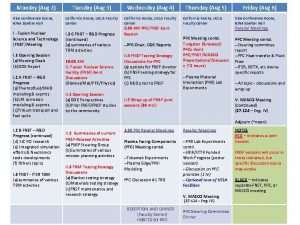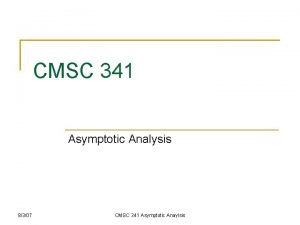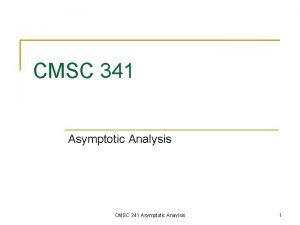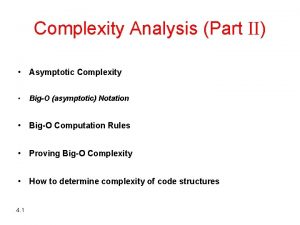Asymptotic Notation Review of Functions Summations 28 Aug



















![Limits w nlim [f(n) / g(n)] = 0 f(n) o(g(n)) w nlim [f(n) / Limits w nlim [f(n) / g(n)] = 0 f(n) o(g(n)) w nlim [f(n) /](https://slidetodoc.com/presentation_image_h/cf9a67eb38f82f18ea2f70595cf24517/image-20.jpg)



















- Slides: 39

Asymptotic Notation, Review of Functions & Summations 28 Aug 2003

Asymptotic Complexity w Running time of an algorithm as a function of input size n for large n. w Expressed using only the highest-order term in the expression for the exact running time. s Instead of exact running time, say (n 2). w Describes behavior of function in the limit. w Written using Asymptotic Notation. asymp - 1 Comp 122

Asymptotic Notation w , O, , o, w w Defined for functions over the natural numbers. s Ex: f(n) = (n 2). s Describes how f(n) grows in comparison to n 2. w Define a set of functions; in practice used to compare two function sizes. w The notations describe different rate-of-growth relations between the defining function and the defined set of functions. asymp - 2 Comp 122

-notation For function g(n), we define (g(n)), big-Theta of n, as the set: (g(n)) = {f(n) : positive constants c 1, c 2, and n 0, such that n n 0, we have 0 c 1 g(n) f(n) c 2 g(n) } Intuitively: Set of all functions that have the same rate of growth as g(n) is an asymptotically tight bound for f(n). asymp - 3 Comp 122

-notation For function g(n), we define (g(n)), big-Theta of n, as the set: (g(n)) = {f(n) : positive constants c 1, c 2, and n 0, such that n n 0, we have 0 c 1 g(n) f(n) c 2 g(n) } Technically, f(n) (g(n)). Older usage, f(n) = (g(n)). I’ll accept either… f(n) and g(n) are nonnegative, for large n. asymp - 4 Comp 122

Example (g(n)) = {f(n) : positive constants c 1, c 2, and n 0, such that n n 0, 0 c 1 g(n) f(n) c 2 g(n)} w 10 n 2 - 3 n = (n 2) w What constants for n 0, c 1, and c 2 will work? w Make c 1 a little smaller than the leading coefficient, and c 2 a little bigger. w To compare orders of growth, look at the leading term. w Exercise: Prove that n 2/2 -3 n= (n 2) asymp - 5 Comp 122

Example (g(n)) = {f(n) : positive constants c 1, c 2, and n 0, such that n n 0, 0 c 1 g(n) f(n) c 2 g(n)} w Is 3 n 3 (n 4) ? ? w How about 22 n (2 n)? ? asymp - 6 Comp 122

O-notation For function g(n), we define O(g(n)), big-O of n, as the set: O(g(n)) = {f(n) : positive constants c and n 0, such that n n 0, we have 0 f(n) cg(n) } Intuitively: Set of all functions whose rate of growth is the same as or lower than that of g(n) is an asymptotic upper bound for f(n) = (g(n)) f(n) = O(g(n)). (g(n)) O(g(n)). asymp - 7 Comp 122

Examples O(g(n)) = {f(n) : positive constants c and n 0, such that n n 0, we have 0 f(n) cg(n) } w Any linear function an + b is in O(n 2). How? w Show that 3 n 3=O(n 4) for appropriate c and n 0. asymp - 8 Comp 122

-notation For function g(n), we define (g(n)), big-Omega of n, as the set: (g(n)) = {f(n) : positive constants c and n 0, such that n n 0, we have 0 cg(n) f(n)} Intuitively: Set of all functions whose rate of growth is the same as or higher than that of g(n) is an asymptotic lower bound for f(n) = (g(n)). asymp - 9 Comp 122

Example (g(n)) = {f(n) : positive constants c and n 0, such that n n 0, we have 0 cg(n) f(n)} w n = (lg n). Choose c and n 0. asymp - 10 Comp 122

Relations Between , O, asymp - 11 Comp 122

Relations Between , , O Theorem : For any two functions g(n) and f(n), f(n) = (g(n)) iff f(n) = O(g(n)) and f(n) = (g(n)). w I. e. , (g(n)) = O(g(n)) Ç (g(n)) w In practice, asymptotically tight bounds are obtained from asymptotic upper and lower bounds. asymp - 12 Comp 122

Running Times w “Running time is O(f(n))” Worst case is O(f(n)) w O(f(n)) bound on the worst-case running time O(f(n)) bound on the running time of every input. w (f(n)) bound on the worst-case running time (f(n)) bound on the running time of every input. w “Running time is (f(n))” Best case is (f(n)) w Can still say “Worst-case running time is (f(n))” s Means worst-case running time is given by some unspecified function g(n) (f(n)). asymp - 13 Comp 122

Example w Insertion sort takes (n 2) in the worst case, so sorting (as a problem) is O(n 2). Why? w Any sort algorithm must look at each item, so sorting is (n). w In fact, using (e. g. ) merge sort, sorting is (n lg n) in the worst case. s Later, we will prove that we cannot hope that any comparison sort to do better in the worst case. asymp - 14 Comp 122

Asymptotic Notation in Equations w Can use asymptotic notation in equations to replace expressions containing lower-order terms. w For example, 4 n 3 + 3 n 2 + 2 n + 1 = 4 n 3 + 3 n 2 + (n) = 4 n 3 + (n 2) = (n 3). How to interpret? w In equations, (f(n)) always stands for an anonymous function g(n) (f(n)) s In the example above, (n 2) stands for 3 n 2 + 2 n + 1. asymp - 15 Comp 122

o-notation For a given function g(n), the set little-o: o(g(n)) = {f(n): c > 0, n 0 > 0 such that n n 0, we have 0 f(n) < cg(n)}. f(n) becomes insignificant relative to g(n) as n approaches infinity: lim [f(n) / g(n)] = 0 n g(n) is an upper bound for f(n) that is not asymptotically tight. Observe the difference in this definition from previous ones. Why? asymp - 16 Comp 122

w -notation For a given function g(n), the set little-omega: w(g(n)) = {f(n): c > 0, n 0 > 0 such that n n 0, we have 0 cg(n) < f(n)}. f(n) becomes arbitrarily large relative to g(n) as n approaches infinity: lim [f(n) / g(n)] = . n g(n) is a lower bound for f(n) that is not asymptotically tight. asymp - 17 Comp 122

Comparison of Functions f g a b f (n) = O(g(n)) a b f (n) = (g(n)) a = b f (n) = o(g(n)) a < b f (n) = w (g(n)) a > b asymp - 18 Comp 122
![Limits w nlim fn gn 0 fn ogn w nlim fn Limits w nlim [f(n) / g(n)] = 0 f(n) o(g(n)) w nlim [f(n) /](https://slidetodoc.com/presentation_image_h/cf9a67eb38f82f18ea2f70595cf24517/image-20.jpg)
Limits w nlim [f(n) / g(n)] = 0 f(n) o(g(n)) w nlim [f(n) / g(n)] < f(n) O(g(n)) w 0 < nlim [f(n) / g(n)] < f(n) (g(n)) w 0 < nlim [f(n) / g(n)] f(n) (g(n)) w nlim [f(n) / g(n)] = f(n) w(g(n)) w nlim [f(n) / g(n)] undefined can’t say asymp - 19 Comp 122

Properties w Transitivity f(n) = (g(n)) & g(n) = (h(n)) f(n) = (h(n)) f(n) = O(g(n)) & g(n) = O(h(n)) f(n) = O(h(n)) f(n) = (g(n)) & g(n) = (h(n)) f(n) = (h(n)) f(n) = o (g(n)) & g(n) = o (h(n)) f(n) = o (h(n)) f(n) = w(g(n)) & g(n) = w(h(n)) f(n) = w(h(n)) w Reflexivity f(n) = (f(n)) f(n) = O(f(n)) f(n) = (f(n)) asymp - 20 Comp 122

Properties w Symmetry f(n) = (g(n)) iff g(n) = (f(n)) w Complementarity f(n) = O(g(n)) iff g(n) = (f(n)) f(n) = o(g(n)) iff g(n) = w((f(n)) asymp - 21 Comp 122

Common Functions 28 Aug 2003 Comp 122, Spring 2004

Monotonicity w f(n) is s s asymp - 23 monotonically increasing if m n f(m) f(n). monotonically decreasing if m n f(m) f(n). strictly increasing if m < n f(m) < f(n). strictly decreasing if m > n f(m) > f(n). Comp 122

Exponentials w Useful Identities: w Exponentials and polynomials asymp - 24 Comp 122

Logarithms x = logba is the exponent for a = bx. Natural log: ln a = logea Binary log: lg a = log 2 a lg 2 a = (lg a)2 lg lg a = lg (lg a) asymp - 25 Comp 122

Logarithms and exponentials – Bases w If the base of a logarithm is changed from one constant to another, the value is altered by a constant factor. s Ex: log 10 n * log 210 = log 2 n. s Base of logarithm is not an issue in asymptotic notation. w Exponentials with different bases differ by a exponential factor (not a constant factor). s Ex: 2 n = (2/3)n*3 n. asymp - 26 Comp 122

Polylogarithms w For a 0, b > 0, lim n ( lga n / nb ) = 0, so lga n = o(nb), and nb = w(lga n ) s Prove using L’Hopital’s rule repeatedly w lg(n!) = (n lg n) s Prove using Stirling’s approximation (in the text) for lg(n!). asymp - 27 Comp 122

Exercise Express functions in A in asymptotic notation using functions in B. A 5 n 2 + 100 n B 3 n 2 + 2 A (B) A (n 2), n 2 (B) A (B) log 3(n 2) log 2(n 3) A (B) logba = logca / logcb; A = 2 lgn / lg 3, B = 3 lgn, A/B =2/(3 lg 3) A (B) nlg 4 3 lg n alog b = blog a; B =3 lg n=nlg 3; A/B =nlg(4/3) as n A o (B) lg 2 n n 1/2 lim ( lga n / nb ) = 0 (here a = 2 and b = 1/2) A o (B) n asymp - 28 Comp 122

Summations – Review 28 Aug 2003 Comp 122, Spring 2004

Review on Summations w Why do we need summation formulas? For computing the running times of iterative constructs (loops). (CLRS – Appendix A) Example: Maximum Subvector Given an array A[1…n] of numeric values (can be positive, zero, and negative) determine the subvector A[i…j] (1 i j n) whose sum of elements is maximum over all subvectors. 1 asymp - 30 -2 2 Comp 122 2

Review on Summations Max. Subvector(A, n) maxsum ¬ 0; for i ¬ 1 to n do for j = i to n sum ¬ 0 for k ¬ i to j do sum += A[k] maxsum ¬ max(sum, maxsum) return maxsum n n j w. T(n) = 1 i=1 j=i k=i w. NOTE: This is not a simplified solution. What is the final answer? asymp - 31 Comp 122

Review on Summations w Constant Series: For integers a and b, a b, w Linear Series (Arithmetic Series): For n 0, w Quadratic Series: For n 0, asymp - 32 Comp 122

Review on Summations w Cubic Series: For n 0, w Geometric Series: For real x 1, For |x| < 1, asymp - 33 Comp 122

Review on Summations w Linear-Geometric Series: For n 0, real c 1, w Harmonic Series: nth harmonic number, n I+, asymp - 34 Comp 122

Review on Summations w Telescoping Series: w Differentiating Series: For |x| < 1, asymp - 35 Comp 122

Review on Summations w Approximation by integrals: s For monotonically increasing f(n) s For monotonically decreasing f(n) w How? asymp - 36 Comp 122

Review on Summations w nth harmonic number asymp - 37 Comp 122

Reading Assignment w Chapter 4 of CLRS. asymp - 38 Comp 122
 Bst time complexity
Bst time complexity Notasi omega
Notasi omega Upper bound asymptotic notation
Upper bound asymptotic notation Indegree and outdegree of graph
Indegree and outdegree of graph Small omega notation
Small omega notation Splitting up summations
Splitting up summations Properties of summation
Properties of summation Summations
Summations Eece ubc
Eece ubc Closed form summations
Closed form summations Bene words
Bene words Translation
Translation Amino acid chart
Amino acid chart Pagsusuri sa el filibusterismo
Pagsusuri sa el filibusterismo Aug q
Aug q Aug comm device
Aug comm device Initiell
Initiell Asimptotik
Asimptotik Information theory asymptotic equipartition principle aep
Information theory asymptotic equipartition principle aep Big o notation for for loop
Big o notation for for loop Asymptotic analysis
Asymptotic analysis Recurrence relation cheat sheet
Recurrence relation cheat sheet Little omega
Little omega Asymptotic growth rate
Asymptotic growth rate Lower bounds for sorting
Lower bounds for sorting Asymptotic freedom
Asymptotic freedom Asymptotic growth
Asymptotic growth Engineering notaion
Engineering notaion Infix notation to prefix notation
Infix notation to prefix notation Polish notation and reverse polish notation
Polish notation and reverse polish notation Polish prefix notation
Polish prefix notation Scientific notation review
Scientific notation review Composite function notation
Composite function notation Function notation and evaluating functions
Function notation and evaluating functions Chapter review motion part a vocabulary review answer key
Chapter review motion part a vocabulary review answer key Uncontrollable spending ap gov
Uncontrollable spending ap gov Nader amin-salehi
Nader amin-salehi Systematic review definition
Systematic review definition Narrative review vs systematic review
Narrative review vs systematic review Functions, domain, and range review
Functions, domain, and range review


